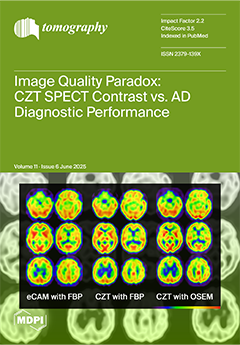Objectives: To assess amide proton transfer weighted (APTw) MR imaging capabilities in differentiating high-grade glial tumors across alpha-thalassemia/mental retardation X-linked (ATRX) expression, tumor-suppressor protein p53 expression (p53), O6-methylguanine-DNA methyltransferase promoter (MGMTp) methylation, isocitrate dehydrogenase (IDH) status, and proliferation marker Ki-67 (Ki-67 index) as
[...] Read more.
Objectives: To assess amide proton transfer weighted (APTw) MR imaging capabilities in differentiating high-grade glial tumors across alpha-thalassemia/mental retardation X-linked (ATRX) expression, tumor-suppressor protein p53 expression (p53), O6-methylguanine-DNA methyltransferase promoter (MGMTp) methylation, isocitrate dehydrogenase (IDH) status, and proliferation marker Ki-67 (Ki-67 index) as a preoperative diagnostic aid.
Material & Methods: A total of 42 high-grade glioma WHO grade 4 (HGG) patients were evaluated prospectively (30 males and 12 females). All patients were examined using conventional MRI, including the following: T1w-MPRAGE pre- and post-contrast administration, conventional T2w and 3D FLAIR, and APTw imaging with a 3T MR scanner. Receiver operating characteristic (ROC) curves were calculated for the APTw% mean, median, and max signal for the different molecular biomarkers. A logistic regression model was constructed for combined mean and median APTw% signals for p53 expression.
Results: The whole-tumor max APTw% signal could significantly differentiate MGMTp from non-MGMTp HGG,
p = 0.035. A cutoff of 4.28% max APTw% signal yielded AUC (area under the curve) = 0.702, with 70.6% sensitivity and 66.7% specificity. The mean/median APTw% signals differed significantly in p53 normal versus p53-overexpressed HGG s: 1.81%/1.83% vs. 1.15%/1.18%,
p = 0.002/0.006, respectively. Cutoffs of 1.25%/1.33% for the mean/median APTw% signals yielded AUCs of 0.786/0.757, sensitivities of 76.9%/76.9%, and specificities of 50%/66.2%,
p = 0.002/0.006, respectively. A logistic regression model with a combined mean and median APTw% signal for p53 status yielded an AUC = 0.788 and 76.9% sensitivity and 66.2% specificity. ATRX-, IDH- wild type (wt) vs. mutation (mut), and the level of Ki-67 did not differ significantly, but trends were found: IDH-wt and low Ki-67 showed higher mean/median/max APTw% signals vs. IDH-mut and high Ki-67, respectively. ATRX-wt vs. mutation showed higher mean and median APTw% signals but lower max APTw% signal.
Conclusions: APTw imaging can potentially be a useful marker for the stratification of p53 expression and MGMT status in high-grade glioma in the preoperative setting and potentially aid surgical decision-making.
Full article






